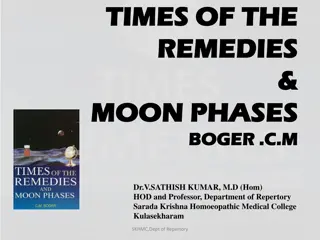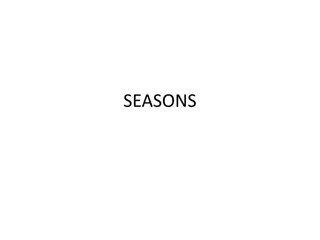Moon Phases, Observations, and Earth's Tilt Study
Explore questions on moon phases, lunar observations, and Earth's tilt in this comprehensive science review. Answer inquiries on lunar phases, moon appearances, and the Earth's position. Engage in activities to predict moon phases, identify specific moon appearances, and comprehend the relationship between Earth, the moon, and the sun.
Download Presentation

Please find below an Image/Link to download the presentation.
The content on the website is provided AS IS for your information and personal use only. It may not be sold, licensed, or shared on other websites without obtaining consent from the author. Download presentation by click this link. If you encounter any issues during the download, it is possible that the publisher has removed the file from their server.
E N D
Presentation Transcript
Test Review Comprehensive SC.8.P .5.9 Which of the moons in the figure are in a gibbous phase? A. 2 and 4 B. 2 and 8 C. 4 and 6 D. 6 and 8
Bonita observes the moon several times during the month of August. She sketches the appearance of the moon on four days August 1, August 9, August 17, and August 24 and identifies each lunar phase. Bonita s data is shown in the table below. On which date should Bonita expect the next new moon to take place? A. August 31 First quarter Full moon Third quarter New moon Lunar phase Date August 1 August 9 August 17 August 24 B. September 7 C. September 12 D. September 22
The phases of the moon are caused by the relative positions of Earth, the sun, and the moon. Lunar phases refer to the appearance of the illuminated portion of the moon as seen by an observer on Earth. When the moon is aligned with and between Earth and the sun, which phase is happening? A. full moon B. new moon C. first quarter moon D. new moon
Oksana observed the appearance of the moon every week for a month. She sketches her observations. Which of these diagrams bestshows how the moon s appearance could have changed during the month Oksana performed her investigation? A B C D
The phases of the moon are the changing appearances of the moon, as seen from Earth. Which phase happens immediately after a waning crescent moon? A. new moon B. waxing gibbous C. waning gibbous D. full moon
Which of these statements correctly describes the rays from the sun received at this point compared to other times during the year? A. The Northern Hemisphere and the Southern Hemisphere both receive less direct rays. B. The Northern Hemisphere and the Southern Hemisphere both receive more direct rays. C. The Northern Hemisphere receives more direct rays, while the Southern Hemisphere receives less direct rays. D. The Northern Hemisphere receives less direct rays, while the Southern Hemisphere receives more direct rays.
The tilt of Earth at four different times throughout the year is shown in the diagram below. At which point would the United States receive the hours hours of daylight? A. position A B. position B C. position C D. position D
Janice wrote in his lab report for a particular phenotype (tt). What can he share about the findings? A. tt would be heterozygous and recessive. B.tt would be homozygous and dominant. C. tt would be homozygous and recessive. D. none of the above
c c C c For a particular trait, the allele C is dominant over the allele c. The Punnett square shows the genetic cross of two parents, each with genotype cc. What percentage of the offspring will show the phenotypes of the dominant allele and the recessive allele? A. 50% will show the phenotype of the dominant allele and 50% will show the phenotype of the recessive allele. B. 50% will show the phenotype of the recessive allele and 50% will show the phenotype of the dominant allele. C. 75% will show the phenotype of the dominant allele and 25% will show the phenotype of the recessive allele. D. 100% will show the phenotype of the dominant allele and 0% will show the phenotype of the recessive allele.
The diagram shows how the organisms get energy. What goes in the box labeled Energy source? A. a fish B. soil C. the sun D. water
An alligator lives in a swamp with deer, birds, fish, trees, and other plants. The alligator eats a bird that eats the seeds and plants. What is the original source of the energy that the alligator gets from eating the bird? A. the flowing water in the swamp B. the energy that the bird creates C. the sunlight that the plants absorb D. the heat from the air in the swamp
The diagram below shows an energy pyramid. In a marine ecosystem, algae carry out photosynthesis. Barracuda eat snapper fish. Reef sharks eat barracuda. Which organism would be at the top of the energy pyramid? A. algae B. barracuda C. reef shark D. snapper fish
Which statement supports the ecosystem represented by the food chain? A. It can support more panthers than deer. B. It can support more deer than panthers. C. It can support the same number of panthers as it can deer. D. The amount of grass does not affect the ecosystem.
Ben wants to model how the motion of particles changes with temperature. He considers water in an iron pot. Ben draws a model to show how the water particles and iron particles move at room temperature. Then, he draws a second model to show how the water particles and iron particles move as the pot of water is heated. How should Ben s second model differ from the first? A. The water particles should vibrate faster, and the iron particles should not move. B. Both the water particles and the iron particles should slide past each other faster. C. The water particles should slide past each other faster, and the iron particles should vibrate faster. D. The water particles should move freely in all directions, and the iron particles should slide past each other faster.
Between which points does water boil? A. 1 to 2 B. 2 to 3 C. 3 to 4 D. 4 to 5
Sunee mixes crushed ice into a glass of cold water. She puts the glass onto the kitchen counter. Then, she measures the temperature of the ice water. What should she expect to happen to the temperature of the ice and water mixture? A. It will stay at 0 C until all of the ice melts. B. It will keep increasing until all of the ice melts. C. It will stay at 0 C until all of the liquid freezes. D. It will keep decreasing until all of the liquid freezes.
Demetri has a certain mass of helium. He measures how the volume of the gas changes at 10-degree temperature intervals. He creates a bar graph of his results. Why does he observe the trend shown in the graph? A. The mass of the helium increases with temperature. B. The helium particles get bigger when they are heated. C. The helium expands as vibrations between the particles that are locked in place increase. D. The amount of space between the particles increases as the helium gains more energy.
The kinetic theory of matter states that matter is made up of tiny particles that are in constant motion. The kinetic theory of matter is most useful in describing which of the following? A. the relationship between mass and weight B. the relationship between a balance and a scale C. the relationship between solids, liquids, and gases D. the relationship between mass, volume, and density
Freezing temperatures can destroy citrus crops. Citrus growers sometimes spray water on the fruit to protect it from freezing. How can spraying the trees with water protect the fruit? A. The temperature of the water changes as it freezes. B. The water releases energy to its surroundings as it freezes. C. The water takes in energy from its surroundings as it freezes. D. Ice coats the fruit, protecting it from cold air.























